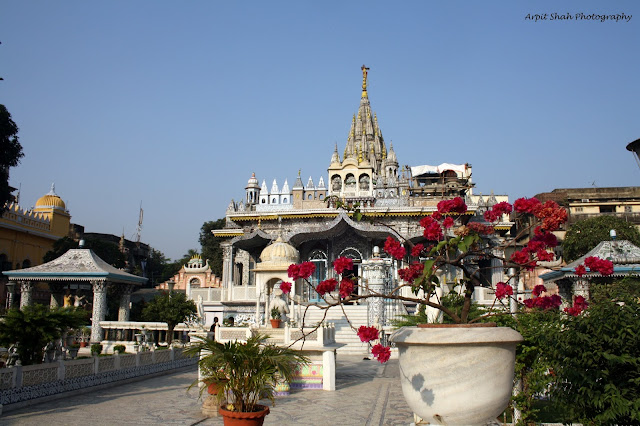Right in the middle of the Maniktalla locality, lies an oasis in the midst of the concrete jungle. The most beautiful of the four temples is dedicated to Shri Shitalnath Bhagwan and was built by Rai Bahadoor Badridas Mookim in 1867. Today, the temple bears the testimony of how devotion can create wonders.
Jainavenue is a medium to serve the spiritual path of Jainism

The magnificient temple of Shitalnath Bhagwan
Badridas Mookim was a descendent of Bhama Shah, the financer and a minister in the court of Rana Pratap of Mewar. His father, Kalkadas Mookim was the official jeweler to Nawab Wajid Ali Shah in Lucknow. However, Badridas migrated from Lucknow to Calcutta after the decline of Nawab Wajid Ali Shah. He established his own business house and subsequently, was appointed as the Court Jeweler to the Viceroy and Governor General of British India. His work was so well appreciated in the British circles that the title of Rai Bahadoor was conferred upon him.
On his visits to the ancient Dadawadi in Maniktalla, Sheth Badridas noticed a pond, barely a few metres away, where the locals used to fish. Being a devout Jain, he could not witness the killing of so many innocent lives. Therefore, he purchased the entire plot where the pond was situated.

The presiding lord: Shri Shitalnath Bhagwan

Rai Bahadoor Badridas Mookim
Later, on the valuable advice of his mother, Smt. Khushal Devi, he decided to make a temple on the plot. In due course the local artisans constructed a temple made of red stone. Although the temple constructed was very grand, Sheth Badridas did not think it was fit to house the lord! He decided to re-design it himself.
The temple was then re-designed with Belgian mirrors, stained glass paintings, European chandeliers, and intricately patterned marble motif floorings. The temple was set within a picturesque and beautifully coloured flower garden filled with striking fountains dotted with exquisitely carved marble statues placed along the pathways. The fish pond was converted into a water reservoir further beautifying the surroundings. It took 25 years to complete the temple!
During this entire period, Sheth Badridas was on the lookout for artisans who could sculpt the main deity (Mulnayak) of the temple. He visited Jaipur and many other distant places from where he would return disappointed as none of the artisans could carve out the statue which Badridas Mookim desired.
Witnessing all his efforts in vain, he went to Acharya Shri Kalyansurishwarji Maharaj. The Acharya Bhagwant blessed and told him that as his wish was so noble, it would get fulfilled very soon. The Acharya Bhagwant also stated that the temple would be dedicated to Shri Shitalnath Bhagwan, the 10th Tirthankar who was the protector of aquatics.

Deity of Acharyashri Kalyansurishwarji Maharaja at the temple
The same night, Badridas Mookim dreamt that he would find the statue in the town of Agra. In accordance with the dream he arrived at Agra. While attending a ceremonial procession, he got into a conversation with an unknown person to whom he narrated the purpose of his journey. Pondering over it for a while, the person took him to the Jain temple situated in Roshan Mohalla and pointed out that beneath the surface he would find the deity he was looking for.
Next day, taking the person, he went to the temple and assured the authorities that he would bear all the expenses incurred post which he had the area dug up. In the process, he came across a staircase, leading down to what appeared to be a Bhoyru (basement). Sheth Badridas descended down the steps and at a considerable depth he was surprised to find a beautiful statue of Shri Shitalnath Bhagwan and a burning lamp next to the statue!

“Shital Swami je dine re, ditho tum dedaar, te din thi man maharu re lagyu tahari laar !”
With due reverence, Sheth Badridas immediately had the statue and the lamp taken out. On ascending the surface, he looked for the person who had directed him to the spot, but he was nowhere to be seen. The statue and the lamp were carried back to Calcutta and were installed in a grand ceremony in the holy presence of Acharya Shri Kalyansurishwarji Maharaj. Till date the lamp has been burning non-stop and thus has been named as the “Akhand Deepak”
Today, the magnificent temple with its slender spires gracing the skyline, lavish archways and ceilings ornamented with stained glass and stone inlay work along with its beautiful cornices running along from pillar to pillar make it a landmark unparalleled in beauty.

The Akhand Deepak – The miraculous lamp

The Rangmandap

The 108 Bulb Chandelier hanging from the gorgeous dome

The beautiful mirrorwork inside the temple

The beautiful mirrorwork inside the temple

The European Chandeliers

View of the temple from outside

View of the temple from outside

Aerial view of the temple

The Shikhara

The doorways

The gardens

Fountains dancing away in the pond

The garden

The gardens
About Author
Arpit Shah is an avid history researcher, devotional singer, and a Jain “vidhikarak” based out of Kolkata. He is a CS and MBA by qualification and works full time at a MNC. He has authored 3 critically acclaimed books (“Dharma Saarthi”, “Prabhu Tamara Pagle Pagle” and Jin Puja – Itihas ke Panno se”) along with 50+ articles on Jain Heritage.



Vey very nice one